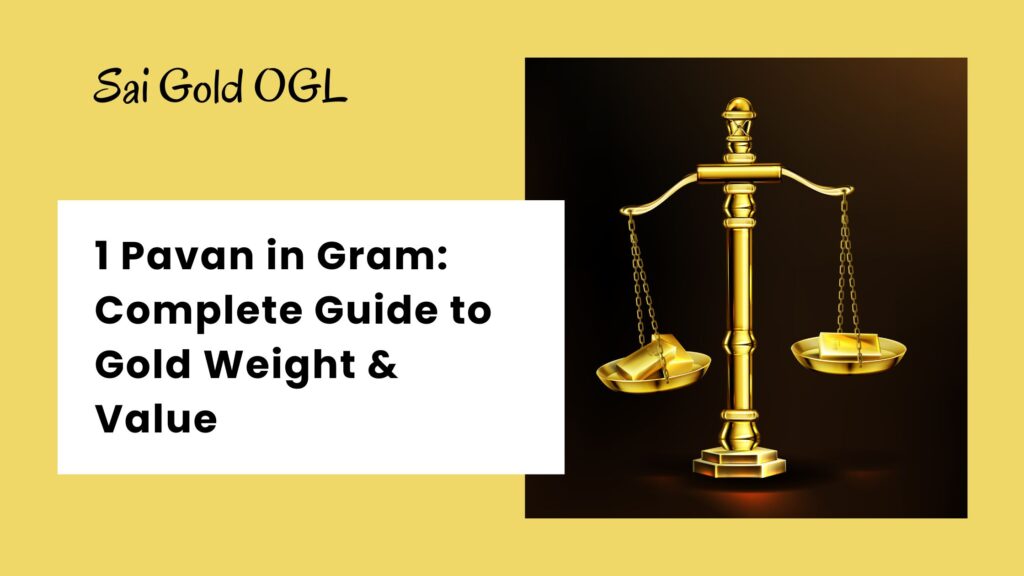In the jewellery markets of South India, especially in states like Kerala and Tamil Nadu, gold is often measured not only in grams but also in a traditional unit called a “Pavan”. If you’ve ever wondered what 1 Pavan in gram means, it equals exactly 8 grams of gold according to multiple conversion guides.
This unit is deeply rooted in local custom: although the metric system uses grams as the standard, the Pavan persists in everyday speech and in jewellery stores across these regions.
So whenever you hear someone say, for example, “2 Pavans of gold”, that corresponds to 16 grams (2 × 8 g).
Why Knowing 1 Pavan in Gram Is Important
- Avoiding confusion: If you know that 1 Pavan = 8 g, you can convert easily and compare prices fairly (whether the jeweller quotes in grams or Pavans).
- Right pricing: Many jewellers or cultural gift-transactions will still quote gold weights in Pavans, so converting to grams ensures you’re comparing apples-to-apples with standard gram-based rates.
- Investment clarity: If you’re buying gold or planning for a wedding or religious gift in South India, you will often see units like Pavans or even “Savaran/Sovereign” (which also equals 8 g) in use.
- Loan or resale scenarios: Gold-backed loans or resale valuations might refer to Pavans in certain regional contexts knowing the gram equivalent is critical for accurate evaluation.
How to calculate the gold value accurately
Here is a step by step method to calculate the value of gold when you know the rate per gram and the weight in Pavans (or grams):
Step 1: Get the current rate per gram
Find out the current market rate of gold for the purity you’re interested in (22K, 24K, etc.). For example:
- Suppose 22 karat gold is ₹ 9,000 per gram.
- Suppose 24 karat gold is ₹ 10,500 per gram.
Step 2: Convert Pavan to Grams (Know 1 Pavan in Gram Value)
If your weight is given in Pavan:
- Number of Pavan × 8 grams = total grams.
Example: 3 Pavan = 3 × 8 = 24 grams.
Step 3: Multiply grams by rate per gram
Using the example above:
- For 22K: 24 g × ₹ 9,000/g = ₹ 216,000.
- For 24K: 24 g × ₹ 10,500/g = ₹ 252,000.
Step 4: Add any additional costs
When buying jewellery (rather than bullion) you must factor in:
- Making charges: The jeweller’s labour/craft cost.
- GST (Goods & Services Tax): In India, jewellery is subject to 3 % GST on the making charges (and possibly on additional service components).
- Wastage or design premium: Some pieces carry extra premium charges.
- Purity difference: Ensure you know whether it’s 22K (≈ 91.6 % pure) or 24K (≈ 99.9 % pure), the rate per gram will differ accordingly. Evn for gold coins and bars, purity matters.
Step 5: Check the final bill & compare
- Verify that the weight (grams) matches what was quoted (or the Pavan equivalent).
- Check that the rate per gram matches the current market rate (or a clearly explained discounted/promoted rate).
- Ensure additional charges are clearly listed and explained.
- Make sure you have a proper invoice/receipt especially important if you might resale or pawn the jewellery later.
Check today’s gold rate in India on Goodreturns.
Example calculation
Let’s walk through a clear example:
- Suppose you’re told: “We have a 2 Pavan gold chain, 22K.”
- Conversion: 2 Pavans = 2 × 8 g = 16 grams.
- Suppose the current 22K rate is ₹ 9,200 per gram.
- Basic gold cost = 16 g × ₹ 9,200/g = ₹ 147,200.
- Suppose making charges = ₹ 5,000, GST = 3% on ₹ 5,000 = ₹ 150.
- Total cost = ₹ 147,200 + ₹ 5,000 + ₹ 150 = ₹ 152,350.
- If you later sell or pledge this item, remember that resale/pawn value may only consider the pure gold weight (16 g) at prevailing rate minus certain deductions for design/making etc.
Also Read: How Gold Prices Affect Your Loan Eligibility
Frequently Asked Questions (FAQs)
The Pavan is a traditional unit especially in South India (Kerala, Tamil Nadu, Karnataka) and persists due to cultural habit, ease of calculation in local jewelers markets, and ritual/gift usage.
According to multiple sources, yes 1 Pavan equals 8 grams.
However, always confirm with the jeweller (especially for very old or custom pieces) that they’re using the standard definition.
You must verify the karat/purity:
24K is essentially pure gold ~99.9 %.
22K jewellery (~91.6 % pure) is common in India for bridal/wedding ornaments.
Rates differ significantly between purities, so the “rate per gram” you use must match the karat.
Use the conversion: Number of Pavan × 8 = grams. Then apply the rate per gram to compute the base cost and compare with other offers quoted per gram.
Yes. For gold loans or resale, banks/traders will typically convert everything into grams and assess purity, weight and current rate. If you have quoted a weight in Pavan, convert to grams (×8) to know what you actually hold. Knowing the gram equivalent helps you estimate the value accurately.







